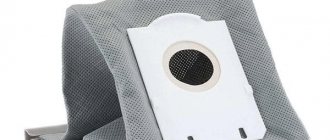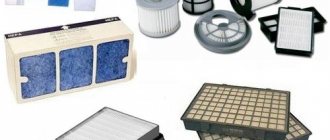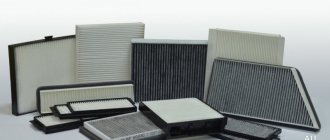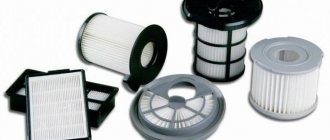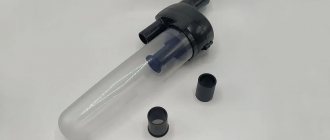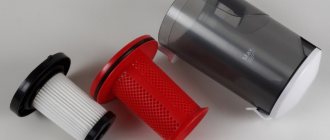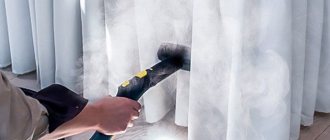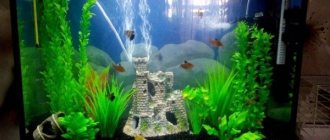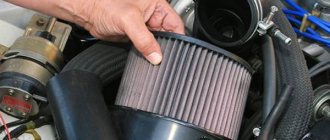The principle of operation of a vacuum cleaner is much deeper than it might seem at first glance. This is not just a suction of garbage... To explain it in simple terms, we can say this: during cleaning, air along with dust is drawn into the device, where, passing through a special filter, it is cleared of it. However, the system is designed in such a way that the air is not pumped into the vacuum cleaner like into a balloon, but comes out back, but completely clean. A multi-stage filtration system comes into play. To prevent it from malfunctioning, it is important to carefully monitor the condition of the filters.
Description
Hepa for a vacuum cleaner
The Hepa filter consists of a fibrous sheet that looks like an accordion, and a housing that holds it in this state. It is made from fiberglass fiber with a diameter of 0.5-2 microns.
The operation of the unit is determined by the volume of particles released into the environment after the air flow passes through it.
The classification is based on the degree of filtration of small contaminants. It is defined by the standards pr EN 1822/ pr DIN 24183.
It is more correct to divide products into ULPA, HEPA, EPA, but consumers call Hepa filters, because they appeared before the names were divided.
Hera filters for modern vacuum cleaners are divided into classes.
| Hera filter class | Dust retention percentage |
| 17 | 99,999995 % |
| 16 | 99.9999 5% |
| 15 | 99.9995 % |
| 14 | 99.995 % |
| 13 | 99.95 % |
| 12 | 99,5 % |
| 11 | 95 % |
| 10 | 85 % |
It is necessary to pay attention to the class when purchasing an additional filter for a vacuum cleaner. The higher it is, the better and more reliable the product.
Life time
It is extremely difficult to know in advance how long the filter will last; if the product is used frequently, the filter may become unusable faster than stated by the manufacturer, and, conversely, if used rarely, the filter may last much longer. However, it is worth focusing on the approximate period and taking care of selecting a replacement filter. In some cases, when purchasing equipment with a non-standard and rare filter shape, it is better to immediately buy replacement products; also, the necessary model can most often be found in a specialized store or on the Internet.
It is very easy to recognize the moment when it is time to replace the filter; at this stage, an unpleasant smell of dust appears when the equipment is operating, the power can also be significantly reduced and an extraneous sound may appear.
Popular types and models
Bosh Nera filter
Types:
- Disposable ones are made from fiberglass or paper. They have a particle throughput of up to 0.3 microns and a service life of up to 6 months.
- Reusable ones are made of fluoroplastic, they can be washed and used for 2 years. They prevent the passage of contaminants up to 0.06 microns in size. They cost more than disposable ones. The names are marked with a W. They are also called Eptfe.
Thus, to decide whether the hepa filter can be washed, you need to consider whether it is disposable or reusable. The price of the device is determined depending on the type, class and brand of the manufacturer. For example, disposable paper filters according to the standard belong to a lower class, unlike fluoroplastic filters, and they will cost less. Let's consider the cost of several devices from the most popular companies.
- Washable Hepa from Bosh H14. Complies with filtration class H14 of the European air hygiene standard. Suitable for vacuum cleaners of the BGS 4 series: BG 42230, BGS 42234, BGS 42242, BGS 4GOLD. Cost - 1400 rubles*.
- Hepa filter H12 for Zelmer vacuum cleaners. Made in Poland. Consists of a special multilayer material. Suitable for models: Galaxy Solaris Twix 5500, Clarris Twix 2750. Cost - 1100 rubles.
- Hepa 13 for DS5500/5600/6000 Mediclean vacuum cleaners. Made in Germany. Cost - 1421 rubles.
- Nera Miele SF-HA30. The device has an integrated replacement indicator, which is activated after installation. A special arrow that lights up in red indicates that it is full. Using an additional function, you can monitor the efficiency of the unit. The plastic case is characterized by strength and resistance to mechanical damage. Cost - 2199 rubles.
- Hepa filter TEFAL ZR005701 belongs to class 10, designed for use in bagless vacuum cleaners of the TW25 series of the Tefal brand. The model consists of a plastic body, a thin layer and deep fibrous material. Its cost is 1099 rubles.
The air passes through the fine cleaning device last, the dust is crushed into even smaller ones, which cannot be seen. The better the model, the more it crushes the dirt.
These products are produced not only by such well-known brands as Philips, Electrolux, Thomson, but also by lesser-known manufacturers. Famous brands often produce filters for their products, and they may not fit the equipment of other companies. This increases the company’s income, since the user in such cases turns to the “native” supplier.
HEPA filter: what is it?
Many models of premium class vacuum cleaners are now equipped with HEPA filters, the main task of which is to finely filter the air leaving the device. Such a filter will easily remove even the smallest dust from the air - from 0.1 to 0.5 microns! By the way, HEPA (High Efficiency Particulate Air) literally translates from English as “highly effective particle retention.” But for this retention to occur at the highest level, the filters need to be cleaned from time to time. Or change.
Criterias of choice
Hepa filter for Miele vacuum cleaner
The efficiency of a unit with a Hepa filter depends on the following parameters:
- material of manufacture;
- fiber diameter;
- packing density.
The suction power is directly proportional to the size - the larger the size, the better the suction. The folds in the unit should not be located often and not very tightly, evenly over the entire surface. The higher the cleaning class of the Nera filter for a vacuum cleaner, the more fragile and delicate components are used in it. Well-known manufacturers make a plastic frame for protection. It is better that it is located over the entire area, and not just a frame around the edge.
Many units are treated with an antimicrobial solution, which prevents the proliferation of microbes.
Note! On the casing material. The filter and the block must be adjacent to each other. If there is no airtight seal between the two mechanisms, operation will become ineffective.
How do you know if the filter needs cleaning?
If, when turned on, your vacuum cleaner begins to emit not the most pleasant aromas ( smell of dust)
or
the suction power decreased,
while the decibels increased (
the noise became louder
), moreover, the device began to
heat up many times faster
- this only means one thing: the filter is clogged with dust and urgently needs to be changed or cleaned! At the same time, it is worth clearly understanding: for half of the filters, washing will be the last event in their lives - they will become deformed and lose their working qualities. To prevent this from happening, take out the instructions and read them.
And if you cleaned up after a recent renovation using a household vacuum cleaner, replacing the filter is inevitable.
Cleaning methods
The reusable filter unit, made of fluoroplastic fibers, can be cleaned. Washing is carried out with strong water pressure without brushes or detergents, so as not to damage the mechanism. Then you need to dry it at room temperature. Users wonder if the hepa filter can be washed frequently. Washing is carried out at least 4 times a year. But even washable products are not recommended to be used for more than two years, because water causes them to lose their properties and become deformed.
Another question arises, is it possible to wash HEPA with a cellulose filter. Disposable paper products should not be attempted to be cleaned because... this will lead to a decrease in the efficiency of their work and the appearance of mold fungi. You can try to clean a filter that is unwashable by blowing air, but this is ineffective. Many dust microparticles are retained between the fibers, cling to them and penetrate inside.
Can the HEPA filter be washed?
Before answering this question, you need to find out what type of filter your filter is. There are disposable
and
reusable
HEPA filters. They differ in the material of manufacture and, accordingly, in the care.
Disposable
The hepa filter is made of fiberglass and cardboard. Or rather, several layers of corrugated paper, which makes it as vulnerable as possible. It is strictly forbidden to wash such a filter! Otherwise, the “accordion” in the shape of which it is made will be deformed and turn into a useless material. Even if after washing the filter will seem completely clean! Particularly persistent ones do not give up attempts to revive the disposable filter - they try to blow them out. But this is also useless! After a couple of such attempts, the filter will finally stop having an effect. Therefore, there is only one piece of advice: without wasting time and effort, replace the filter! Moreover, it costs pennies.
Reusable (replaceable)
HEPA
filter
costs several times more, because it is made of synthetic materials. More often - from fluoroplastic. Perfectly neutralizes odors and traps microscopic dust particles. It is more durable. The fact that such a filter is not afraid of water, which means it can be safely wetted, is evidenced by the letter “W” (washing) in the model name and in the vacuum cleaner instructions.
What is the CADR of the Tion Clever cleaner?
In the USA and China, manufacturers are required to indicate the CADR of air purifiers.
This does not exist in Russia yet. We measured the CADR of our purifier on our own initiative. We tested the effectiveness of Tion Clever on the AC-1 aerosol stand. For fine aerosol with PM2.5 particles, the single-pass efficiency of the device is more than 95%. The productivity of the device is 150 m3/h. We get CADR = 142.5.
Tion Clever was developed for air disinfection in medical wards and offices. Its CADR meets medical requirements for ensuring air sterility in healthcare facilities. One Tion Clever will provide three times the air exchange in rooms with a volume of about 50 m3, that is, an area of about 20 m2. For larger rooms, several devices are installed.
In the photo there are two Tion Clever in the operating unit of one of the Moscow hospitals: one on the wall, the other on a mobile stand.
We present you with an elementary task.
One Tion Clever stands in a room with an area of 20 m2 and a ceiling height of about 2.5 m. For simplicity, let's assume that there are no sources of particles in the room.
How long will it take for Tion Clever to reduce the concentration of PM2.5 particles by 100 times? That is, it will purify the air in the room by 99%. View solution
Calculate the volume of the room: V = 20 m2 * 2.5 m = 50 m3The initial concentration of PM2.5 particles in the air is N0. After time t it should decrease 100 times: Nt = 0.01 * N0
The concentration in the air varies according to the law: Nt = N0 * exp (- CADR * t / V)
We substitute known values and calculate the time after which the air will be cleared by 99%: 0.01 * N0 = N0 * exp (- 142.5 * t / 50) 0.01 = exp (-2.85 * t) ln (0 .01) = -2.85 * t -4.6 = -2.85 * tt = 1.6
Answer: After about an hour and a half, Tion Clever will purify the air in the room by 99%.
How to measure the CADR of a purifier
It is possible to measure CADR directly.
We measure the single-pass efficiency of the device on an aerosol stand and multiply it by the performance of the device. This is the most accurate way to measure CADR. But aerosol stands in Russia can be counted on one hand, so it will be difficult to calculate CADR directly. The AHAM Association has proposed a simplified methodology. In it, CADR is not measured directly, but through directly measuring the efficiency of air purification. In this case, you do not need to know either the single-pass efficiency of the device or its productivity.
Let's measure the CADR of the purifier according to PM2.5 using a simplified method.
We put a purifier in the isolated room, but don’t turn it on yet. We inject a certain amount of PM2.5 aerosol into the room air. We measure the concentration of particles at different times: after a minute, 10 minutes, half an hour, 45 minutes, an hour, two, and so on.
We ventilate the room and again let in the same amount of PM2.5. Turn on the purifier. We measure the concentration of particles in the air at the same time intervals.
We get two series of measurements: without a cleaner and with a cleaner. The obtained data is approximated by an exponential. The first exponential shows the natural deposition of particles on walls and floors. The second is natural sedimentation and settling of particles in the purifier.
We subtract one from the other and get the final exponential of particle deposition in the purifier. Find the exponent: (- CADR / V)
. We know the volume of the room, it’s easy to calculate CADR.
This measurement method is less accurate than using an aerosol stand. But it is much simpler. The error can be reduced if a large series of measurements is carried out.
Which devices have a HEPA filter?
There are quite a lot of them: first of all, these are air purifiers, air conditioners and vacuum cleaners. We have collected just a few examples.
Vacuum cleaner Samsung VC20M25
- dry cleaning
- with bag and container 2.50 l
- suction power: 460 W
- power consumption: 2000 W
- fine filter included
- dust bin full indicator, power regulator on the body
- telescopic suction pipe
- WxHxD: 24.60x28x39 cm
Inexpensive, powerful corded vacuum cleaner with several degrees of filtration. A transparent cyclone filter is installed on the handle, which traps large debris, small debris settles in a bag (2.5 liters), and dust is retained by a HEPA filter. The set includes a nozzle with a brush, for storage of which there is a compartment under the cover of the device. The vacuum cleaner is equipped with protection that will not allow it to start without a dust bag installed.
Vacuum cleaner KARCHER VC 3
- dry cleaning
- with container 0.90 l
- suction power: 250W
- power consumption: 700 W
- fine filter included
- telescopic suction pipe
- WxHxD: 26.90×33.40×38.80 cm
Quiet, compact, bagless corded vacuum cleaner. Instead, a cyclone filter is installed, the filling of which is easy to control thanks to the transparent container. The kit includes several attachments for different surfaces. The pre-filter can be easily removed and washed, thereby saving money on buying bags. But the installed HEPA filter must be changed.
Air purifier ATMOS VENT-1307
- serviced area 40 m2
- productivity 135 m3/hour
- air ionization
- pre-filter, carbon filter, HEPA filter
- work speed adjustment
- power 12 W
A compact device for multi-stage air purification, suitable for small rooms up to 40 m2. The device has a fashionable cylindrical design, touch controls and stylish backlighting with three brightness levels. It works like this: with the help of fans, air is sucked into the purifier and passes through 4 levels: a primary mesh filter, a carbon filter, a HEPA filter and a negative oxygen ion generator. The air comes out of the device completely clean. Conveniently, the purifier has 4 speed modes, including night mode with a reduced noise level. The device can also notify you that the filters are dirty and it’s time to change them.
Air purifier Xiaomi Mi Air Purifier 2C
- serviced area 42 m2
- productivity 350 m³/hour
- work speed adjustment
- power 33 W
A small purifier with a futuristic design that will fit into a modern interior. It has three levels of cleaning: a standard mesh for large debris (such as hair), a carbon and HEPA filter. An advantage is the ability to control from a smartphone through a proprietary application, in which you can adjust the temperature and humidity, as well as set the operating mode (normal or night). The app will also notify you when it's time to change the filters.
You will find even more air purifiers of different classes in this selection.
It is important not only to breathe clean air, but also to drink clean water. We also have a useful article about choosing filters for your home.
Application
Thanks to its unique filtration system, this product has become widespread and is especially suitable for use in rooms where there are children or people with allergies. HEPA filters are used mainly in three directions:
- For vacuum cleaners
- For ventilation
- For air purifiers.
INFORMATION:
There are no analogues to the unique HEPA fine cleaning system, which is why they are found on almost every air purifier, differing only in the material and filter class.
For the most part, washable H10 filters are found in vacuum cleaners, but you can also find paper filters; you should definitely pay attention to this when purchasing. Air purifier filters most often feature an enlarged plastic housing, which guarantees protection at such a high efficiency of the product. For cleaners, H11 is most often used, but other classes may also be found in products whose price is significantly higher. It is important to remember that filters of even the same class are completely different and are not interchangeable, especially for equipment with different purposes.
What if you can’t and other pitfalls
How to wash a vacuum cleaner filter if you find out that it is disposable? The answer, unfortunately, is simple: no way. Often, you want to believe that you can bypass the manufacturer’s instructions and recommendations, because sometimes we manage to wash disposable tableware?
However, in this case our recommendations are clear. If you place a disposable HEPA filter under water, it will lose its so-called “accordion” structure. In a simple way, it will “fall apart” and cease to be a filter in principle.
How to provide care? Here the manufacturer offers an option - cleaning the HEPA filter with a brush. A completely workable option, by the way.
Another way is to replace the old filter. In our Mi Fan store you will find filters for different models of vacuum cleaners here.
In general, I must say, the life of even reusable filters is not that long. It's all about the heavy load - a lot of passing air.
Therefore, regularly replacing filters is the key to high-quality operation of your devices.
Have healthy air with mi-fan.ru
How often should you change the filter in a vacuum cleaner?
Brooms, brushes, sponges and mops: this “guard” can be successfully replaced by one vacuum cleaner . Where the clever unit walked, not a trace of dirt and dust remained. Minimum time and effort: the apartment is shiny, clean and fresh air. However, there is one caveat: if you want the quality of cleaning to remain high, do not forget to clean and change the filters.
How to understand when it's time to replace the filter
Experts from ALM-zapchasti named 3 main signs indicating the need to replace the filter:
- the power of the vacuum cleaner has decreased;
- the engine overheats and makes a loud noise;
- The vacuum cleaner does not clean as well as before: dust remains after use.
The frequency of replacement depends on the type of filters, frequency of use of the unit and the size of the apartment. Don’t forget to change the filters so that the vacuum cleaner works for a long time and cleans efficiently.
Page 132
— Do not rinse the housing with the cylindrical filter not removed in water,
since the cylindrical filter is not waterproof (Fig. 43).
Insert the cylindrical filter back into the housing (1) and turn it clockwise
arrow to lock (2) (you should hear a click) (Fig. 44).
Before installing the cylinder filter, the cylinder filter housing must
Place the cylindrical filter unit back into the dust bin (should
a click will sound) (Fig. 45).
The dust container must be dry before installing the cylindrical filter unit.
Place the dust container back into the appliance (Fig. 46).
Close the lid tightly (you should hear a click) (Fig. 47).
Note: If the dust bin and/or cylinder filter is not installed properly
Thus, the device will not work and the mode indicator on the device cover will flash
Cleaning the motor protection filter
The motor protection filter should be cleaned every two months.
Disconnect the device from the power supply.
Remove the motor protection filter from the appliance and clean it by shaking it over
trash can (Fig. 48).
If more thorough cleaning of the motor protection filter is necessary, it
can be washed under running water. Do not use liquid or other liquids to clean the motor protection filter.
detergents and flammable substances!
Carefully install the cleaned motor protection filter into place, tightly
Before installing the motor protection filter, make sure it is completely dry.
Washable filter ultra Clean air HePa 13
The washable HEPA 13 filter is capable of retaining up to 99.95% of all dust particles up to
0.0003 mm. This is not only ordinary house dust, but also harmful microscopic
insects such as dust mites and their excrement, which cause respiratory allergies. Note: To ensure optimal dust filtration and vacuum cleaner performance, always
replace the HEPA filter with an original Philips filter of the required type (see chapter “Ordering
accessories and filters”).
Clean the washable HEPA 13 filter every 6 months. Clean the washable HEPA filter
13 can be no more than 4 times. Replace the filter after 4 cleanings. Note: The HEPA 13 filter cannot be washed in a washing machine. Follow the instructions
Disconnect the device from the power supply.
filter cover (Fig. 49).
Remove the washable HEPA filter 13 (Fig. 50).
Source
How to choose?
As a rule, the latest generation vacuum cleaners are already equipped with fine filters. Those of them that do not have a secondary filtration function have free spaces intended for the installation of additional equipment. In the latter case, the buyer himself makes the decision to purchase and install HEPA.
A primitive filtration system is installed on inexpensive equipment. Paper garbage bags are disposable and therefore are thrown away along with the trash either immediately after cleaning is completed or when they are full. Reusable linen bags become clogged with dust.
